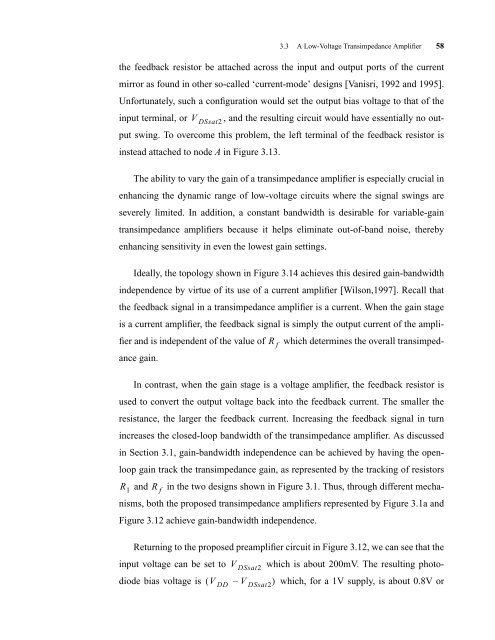CMOS Optical Preamplifier Design Using Graphical Circuit Analysis
CMOS Optical Preamplifier Design Using Graphical Circuit Analysis
CMOS Optical Preamplifier Design Using Graphical Circuit Analysis
You also want an ePaper? Increase the reach of your titles
YUMPU automatically turns print PDFs into web optimized ePapers that Google loves.
3.3 A Low-Voltage Transimpedance Amplifier 58<br />
the feedback resistor be attached across the input and output ports of the current<br />
mirror as found in other so-called ‘current-mode’ designs [Vanisri, 1992 and 1995].<br />
Unfortunately, such a configuration would set the output bias voltage to that of the<br />
input terminal, or , and the resulting circuit would have essentially no out-<br />
put swing. To overcome this problem, the left terminal of the feedback resistor is<br />
instead attached to node A in Figure 3.13.<br />
The ability to vary the gain of a transimpedance amplifier is especially crucial in<br />
enhancing the dynamic range of low-voltage circuits where the signal swings are<br />
severely limited. In addition, a constant bandwidth is desirable for variable-gain<br />
transimpedance amplifiers because it helps eliminate out-of-band noise, thereby<br />
enhancing sensitivity in even the lowest gain settings.<br />
Ideally, the topology shown in Figure 3.14 achieves this desired gain-bandwidth<br />
independence by virtue of its use of a current amplifier [Wilson,1997]. Recall that<br />
the feedback signal in a transimpedance amplifier is a current. When the gain stage<br />
is a current amplifier, the feedback signal is simply the output current of the ampli-<br />
fier and is independent of the value of which determines the overall transimped-<br />
ance gain.<br />
In contrast, when the gain stage is a voltage amplifier, the feedback resistor is<br />
used to convert the output voltage back into the feedback current. The smaller the<br />
resistance, the larger the feedback current. Increasing the feedback signal in turn<br />
increases the closed-loop bandwidth of the transimpedance amplifier. As discussed<br />
in Section 3.1, gain-bandwidth independence can be achieved by having the open-<br />
loop gain track the transimpedance gain, as represented by the tracking of resistors<br />
R 1<br />
and in the two designs shown in Figure 3.1. Thus, through different mecha-<br />
R f<br />
V DSsat2<br />
nisms, both the proposed transimpedance amplifiers represented by Figure 3.1a and<br />
Figure 3.12 achieve gain-bandwidth independence.<br />
R f<br />
Returning to the proposed preamplifier circuit in Figure 3.12, we can see that the<br />
input voltage can be set to which is about 200mV. The resulting photo-<br />
V DSsat2<br />
diode bias voltage is ( – )<br />
which, for a 1V supply, is about 0.8V or<br />
V DD<br />
V DSsat2














